We can’t make this stuff up!
Will SCOTUS Justices recuse themselves from BP Oil Disaster Case?
Stories of Survival, Resiliency and Recovery
We can’t make this stuff up!
Will SCOTUS Justices recuse themselves from BP Oil Disaster Case?
 The giveBIG Challenge starts in six (6) hours.
The giveBIG Challenge starts in six (6) hours.
We’re excited to participate in the Seattle Foundation’s Fourth Annual giveBIG Challenge tomorrow, Tuesday, May 6th.
All donations made through the Seattle Foundation website during the 24-hour giveBIG event will be ‘stretched’ by The Seattle Foundation and giveBIG sponsors. This means that donations of any size, big or small, will make an even greater impact.
Your donation will automatically enter you into a drawing to win a golden ticket! The golden ticket will provide an additional $1,000 to your donation and you will win a $100 gift card. The Seattle Foundation will announce the winning nonprofits and donors on social media throughout the day.
Mark your calendar and encourage your friends to donate by forwarding this e-mail and sharing our Facebook and Twitter posts.
giveBIG to the Mooontown Foundation TOMORROW!
#GivingTuesday
An event showcasing the creative works of three critically acclaimed Pacific Northwest artists using the power of film, music, and social media to both honor the victims of the disaster and celebrate the resiliency of the Japanese people.
SPECIAL ANNOUNCEMENT:  World renown disaster response expert, Gisli Olafsson to speak at Great East Japan Earthquake and Tsunami Remembrance Event. Olafsson is the Emergency Response Director of NetHope and author of “The Crisis Leader,” and is considered as a disaster experts, expert. Gisli has over 15 years of experience in the field of disaster management, and is the Emergency Response Director of NetHope, an organization that uses information communication technology to help humanitarian organizations like the United Nations, International Federation of Red Cross, World Bank, USAID and NATO respond to natural and human-caused disasters. http://youtu.be/c3FmozRenhE Gisli is a member of the UN’s Disaster Assessment and Coordination team, a team of experienced disaster managers that can deploy anywhere in the world on 6-hours notice to coordinate the first response of the international community to disasters on behalf of the UN Office for Coordination of Humanitarian Affairs. Gisli was a team leader for Iceland’s international Urban Search and Rescue team (ICE-SAR) after the Haiti Earthquake in 2010 and has served as part of Iceland’s National Search and Rescue Command. Locally, Gisli was a lead member of King County’s Emergency Operation Centre’s Support team and took part in coordinating over 100 disaster management and SAR incidents. In recent years Gisli has participated in disaster field missions in connections with floods in Ghana (2007), Cyclone Nargis in Myanmar (2008), Hurricane Ike in Texas (2008), Sichuan Earthquake (2008), Pandemic Outbreak (2009), West Sumatra Earthquake (2009), Haiti Earthquake (2010), Japan Earthquake/Tsunami (2011) and Horn of Africa famine (2011).
World renown disaster response expert, Gisli Olafsson to speak at Great East Japan Earthquake and Tsunami Remembrance Event. Olafsson is the Emergency Response Director of NetHope and author of “The Crisis Leader,” and is considered as a disaster experts, expert. Gisli has over 15 years of experience in the field of disaster management, and is the Emergency Response Director of NetHope, an organization that uses information communication technology to help humanitarian organizations like the United Nations, International Federation of Red Cross, World Bank, USAID and NATO respond to natural and human-caused disasters. http://youtu.be/c3FmozRenhE Gisli is a member of the UN’s Disaster Assessment and Coordination team, a team of experienced disaster managers that can deploy anywhere in the world on 6-hours notice to coordinate the first response of the international community to disasters on behalf of the UN Office for Coordination of Humanitarian Affairs. Gisli was a team leader for Iceland’s international Urban Search and Rescue team (ICE-SAR) after the Haiti Earthquake in 2010 and has served as part of Iceland’s National Search and Rescue Command. Locally, Gisli was a lead member of King County’s Emergency Operation Centre’s Support team and took part in coordinating over 100 disaster management and SAR incidents. In recent years Gisli has participated in disaster field missions in connections with floods in Ghana (2007), Cyclone Nargis in Myanmar (2008), Hurricane Ike in Texas (2008), Sichuan Earthquake (2008), Pandemic Outbreak (2009), West Sumatra Earthquake (2009), Haiti Earthquake (2010), Japan Earthquake/Tsunami (2011) and Horn of Africa famine (2011).
Buckman Coe, recently voted second-best unsigned band in the Vancouver (B.C.) weekly Georgia Straight’s reader’s choice contest, is a soul, folk and reggae artist whose lyrics show a keen understanding of human emotion and reflect a Zen-like calm and inner peace. Coe will perform a collection of songs including “Stars Over Tokyo,” a soulful and emotional tribute to the residents of Tokyo in the aftermath of the Great Tōhoku Earthquake.

Reactor, a documentary film by Canadian media activist and filmmaker Ian MacKenzie, is a meditative, deliberate, powerful half-hour glimpse into the world of post-Fukushima Japan. Choosing not to dwell on the magnitude 9.0 Tōhoku-Oki earthquake and tsunami three years ago — and the subsequent nuclear catastrophe that has supplanted Chernobyl as the worst disaster of the Atomic Age — Reactor is about the response, as the initial shock fades and long-term repercussions and a new reality permeate the nation’s consciousness.
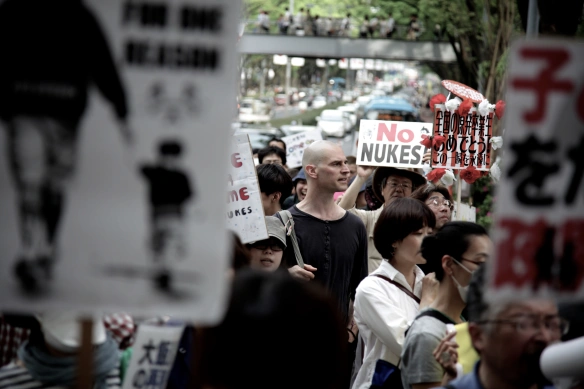
SEATTLE, WA – Tuesday, March 11th, 2014, marks the third anniversary of the magnitude 9.0 earthquake that hit the Tohoku region of Japan producing a massive tsunami that killed an estimated 18,000 people, caused $122B dollars of damage, and led to the eventual meltdown of three reactors at the Fukushima Daiichi nuclear power plant. The environmental, social, and economic impacts of this historic disaster will be felt for decades.
To commemorate the on-going crisis and celebrate the resiliency of the Japanese people, Moontown Foundation and KING5 TVs Lori Matsukawa are hosting a special information session and screening of Canadian media activist and filmmaker Ian MacKenzie’s short film Reactor, a meditative, deliberate, quietly powerful half-hour glimpse into the uncharted new world of post-Fukushima Japan.
Choosing not to dwell on the magnitude 9.0 Tōhoku-Oki earthquake and tsunami nearly three years ago — and the subsequent nuclear catastrophe that has supplanted Chernobyl as the worst disaster of the Atomic Age — it’s about the response, as the initial shock fades and long-term repercussions and a new reality permeate the nation’s consciousness.
Reactor – Trailer from Ian MacKenzie on Vimeo.
Ultimately, it’s an exploration of humanity and what connects us all. Its beauty resides in its subtlety, in the equanimity and restraint exemplified by the Buddhism of its central character and emotional core, yogi/teacher/activist Michael Stone; there’s no tub-thumping (though drums are struck in a protest on the streets of Tokyo). MacKenzie lets the story tell itself, through articulate voices — a protestor, an academician, an activist — offering detail and context.
The most haunting words are softly, plaintively spoken by Hiroshima survivor Keiko Ogura, who says “I feel so sorry for Fukushima people” after describing the horror she witnessed as an 8-year-old — the flash of the atomic bomb’s detonation like “a thousand suns.” A final, intensely personal message of hope and call for action is tempered by the reality that a new government has reversed course and is doubling down on Japan’s nuclear future.
EVENT DETAILS:
Date: Tuesday, March 11, 2014
Time: 6-7PM, Reception; 7-9PM, Screening and Discussion
Admission: $25 Private Reception; $15 General Admission
Location: Wing Luke Museum, 719 South King St., Seattle, WA 98104
Tickets: Brown Paper Tickets
Light appetizers and refreshments provided. Special musical guest Buckman Coe. Interpretive services upon request. Seating capacity limited.
About Ian Mackenzie
Based in Vancouver, British Columbia, Ian Mackenzie is a video journalist, media activist, and documentary filmmaker. Mackenzie’s work has appeared in The New York Times, National Geographic TV, Canadian Broadcasting Channel, Adbusters, and film festivals around the world. He co-produced Velcrow Ripper’s feature documentary Occupy Love (2013). Sacred Economics (2012), produced in collaboration with author Charles Eisenstein, is one of his most popular web films. Ian’s short film, The Revolution Is Love (2011) was named one of the top 10 films chronicling the Occupy Movement of 2011. In 2010, he released One Week Job, an inspirational story about a guy who worked 52 jobs in 52 weeks to find his passion. The project received widespread attention from the New York Times and CNN. To learn more visit www.ianmack.com.
About Buckman Coe
Buckman Coe is a Yogi, Soul, Folk and Reggae Artist from Vancouver, British Columbia. With a background in Human Geography and Counseling Psychology, his lyrics show a keen understanding of human emotion; a concern for the Earth and his music reflects a Zen-like calm and inner peace. Coe favors bright, shimmering melodies in the style of Paul Simon and Neil Young. His voice is a gossamer falsetto that recalls the grace and elegance of the late Jeff Buckley. His lyrics eschew the simplistic rhyming couplets of much folk music for intricate and sometimes subversive passages that go much deeper than the easy-listening veneer of his melodies. To learn more visit www.buckmancoe.com.
Children of the Tsunami is a powerful documentary film depicting stories of survival in the aftermath of the Great East Japan Earthquake and Tsunami that struck the Tohoku region of Japan on March 11, 2011; as told by 7-10 year old youth.
March 11th, 2014, marks the 3-year anniversary of the magnitude 9.0 earthquake that hit the Tohoku region of Japan producing a massive tsunami that killed over 18,000 people, caused $122B dollars of damage, and led to the eventual meltdown of three reactors at the Fukushima Daiichi nuclear power plant. The environmental, social, and economic impacts of this historic disaster will be felt for decades.
Join us for a special information session and screening of the documentary film REACTOR.
Produced and directed by critically acclaimed Canadian filmmaker Ian Mackenzie (OCCUPY LOVE, SACRED ECONOMICS, ONE WEEK JOB), REACTOR follows Michael Stone, a Yogi and Buddhist monk, on his inspirational pilgrimage to Japan in the aftermath of the disaster to witness firsthand how the Japanese are responding to the on-going crisis.
Official Trailer: http://http://www.reactorfilm.com
EVENT DETAILS:
Light appetizers and refreshments provided. Special musical guest Buckman Coe. Interpretive services upon request. Seating capacity limited.
Email info [at] moontownfoundation [dot] org for more information.
A fascinating article covering the story of Isaac Cline and his journey to rebuild his life and sense of purpose after surviving the Galveston Hurricane of 1900.

Explore damage from Typhoon Haiyan/Yolanda by browsing photos from Twitter, Facebook, news articles, and other websites curated with the MicroMapper platform. Click a point on the map to see the image from that area – See more at: http://www.esri.com/services/disaster-response/hurricanes/typhoon-haiyan-yolanda-photo-tour#sthash.z009ydA8.dpuf
“Winging it is not an emergency plan. #Prepared2014 http://thndr.it/1cAW4cc”
Most people give immediately after a crisis, in response to clear emotional appeals. Yet donors who allocate funds across the disaster life cycle have an opportunity to help insure that each dollar given reaches its full potential. This presentation discusses how individuals and organizations traditionally give during a crisis, and proposes several innovative approaches to promoting short- and long-term solutions to help communities prepare for, respond to, and recover from disasters.
Yesterday, December 5, 2013, I celebrated my 45th birthday.
Every year on this date, I make a point to start my day by being mindful and thankful. Thankful for having loving family and friends, and thankful for the sacrifices so many others have made so that I can live a life of freedom; though ever mindful of that fact that freedom doesn’t come for free.
 December 5th is a date of significance for me NOT because it is the date of my birth, but because it is the same day the historic bus boycott in Montgomery Alabama was launched in 1955, after Rosa Parks, “Mother of the Civil Rights Movement,” refused to move to the back of the bus when she was ordered to give up her seat to a white person.
December 5th is a date of significance for me NOT because it is the date of my birth, but because it is the same day the historic bus boycott in Montgomery Alabama was launched in 1955, after Rosa Parks, “Mother of the Civil Rights Movement,” refused to move to the back of the bus when she was ordered to give up her seat to a white person.
This was a seminal event in U.S. history, which ultimately led to a United States Supreme Court decision (Browder v. Gayle), that declared the Alabama and Montgomery laws requiring segregated buses to be unconstitutional.
The ripple effect of Rosa Park’s refusal to give up her seat and the subsequent Supreme Court decision catalyzed the National Civil Rights Movement that gave rise to the leadership of Dr. Martin Luther King – a clergyman, activist, and one of the finest humanitarians to have every walked this Earth – until his untimely demise at the hands of a sniper at the age of 39.
If Dr. Martin Luther King Jr. had survived, he would be celebrating his 85th birthday next month.
Yesterday the world lost another truly amazing leader, not due to violence, but to the cumulative effects of age. At 95 years of age at his passing, Nelson Mandela, the former South African president and Nobel Peace Prize winner, was the epitome of patience, positivity, and perseverance.
Today, I find it shocking to believe that so many do not know his story, a story of transformation; from warmongering political freedom fighter, to prisoner, to president. I mean, come on. Nelson Mandela was portrayed by Morgan Freeman in the Oscar nominated film Invictus, starring Matt Damon. And who doesn’t know Morgan Freeman or Matt Damon? Or better yet, how could one fail to witness the out pouring of love and respect for Nelson Mandela during the 2010 FIFA World Cup in South Africa.
FIFA World Cup South Africa 2010 (Official Theme Song)
www.youtube.com/watch?feature=player_detailpage&v=BgyJY9yndv4
With all due respect, there was a time in my life when I didn’t know who Nelson Mandela was, what he stood for, or what he sacrificed personally; namely his freedom.
Twenty-seven years ago I had never heard of Nelson Mandela, of South Africa, or apartheid. I was an 18-year old college freshman. The year was 1986. At that time I had no interest in political activism or community organization, and social justice was not part of my daily lexicon.
In the mid-1980s, there was something happening on college campuses all across our country called “the anti-apartheid movement,” which was bringing together students of different races and cultures, in a way our country had not seen since the Civil Rights Movement of the 1960s. I was a college student attending the University of Montevallo Alabama at the time, about 20 minutes from Selma – a city made infamous for the Bloody Sunday violence in 1965 – and an hour away from Montgomery. I knew the movement was a big deal culturally. After all, I was living in the Deep South, a place with a long history of racial hatred.
Selma-to-Montgomery Civil Rights March in 1965
It has taken almost 30 years for the full appreciation of this historic awakening to fully set in.
College students across the country were self-organizing and leading protests, boycotts, sit-ins, and commandeering buildings, demanding for their schools, for corporations, and our federal government to divest, or de-invest billions of dollars in stocks, capital goods, and real estate from South Africa, to the point that the economic impact of apartheid became too costly for the South African government to continue. Thus it was subsequently dismantled.
Amid harsh financial outcomes and facing mounting political strife internationally, Nelson Mandela was granted his freedom. I remember the day he was released from 27-years in prison. CNN carried the story live.
It was a seminal moment in world history, akin to the demise of the Berlin Wall. It was February 11, 1990. I sat glued to the television in my dorm listening to a man that was humble and courageous, hopeful and gracious as he spoke before thousands of South Africans in Cape Town and to millions more by television.
“Comrades and fellow South Africans, I greet you all in the name of peace, democracy and freedom for all,” Mandela told tens of thousands of cheering supporters.
His smile was infectious, his words were hypnotic, and his presence was out of this world. In my mind, he became the embodiment of the best that humanity has to offer. His ability to forgive, to turn his anger, his hatred, his suffering into love, and finally, reconciliation, were a game changer for me.
It was the 1st time in my life that I understood the cliché that one person can make a difference in this world.
Today, as the world mourns the loss of Nelson Mandela, I’d like to introduce you to one of my unsung heroes, a heroine actually, that you may never have heard of. Her name is Cherri Foytlin and she is a resident of Rayne, Louisiana.
Cherri is a human rights advocate, community organizer, journalist, mother to six of the best-behaved kids I have ever met, and one of five main characters profiled in my, yet to be released, documentary film Storm Surge.
I was introduced to Cherri via Facebook in July of 2010, but didn’t meet her face to face until July of 2011. That’s when I saw her speak at a Gulf Coast Restoration Task Force meeting being facilitated by Lisa Jackson, former EPA Administrator. “We still have oil in our marshes, fishermen are out of work and it seems like everyone knows someone with cancer. It’s time to take the blinders off and see what this industry is doing to us,” argued Foytlin.
 Cherri was fresh off a 1,243 mile walk from New Orleans to Washington D.C. to raise awareness of the ongoing environmental, social and economic impact of the BP Deepwater Oil Disaster, which was being compounded by lingering impacts of Hurricanes Katrina, Gustav, Rita, and Ivan, and the institutionalized lack of healthcare, educational, and job opportunities in Gulf Coast communities – beyond the oil and gas industries.
Cherri was fresh off a 1,243 mile walk from New Orleans to Washington D.C. to raise awareness of the ongoing environmental, social and economic impact of the BP Deepwater Oil Disaster, which was being compounded by lingering impacts of Hurricanes Katrina, Gustav, Rita, and Ivan, and the institutionalized lack of healthcare, educational, and job opportunities in Gulf Coast communities – beyond the oil and gas industries.
Since then Cherri has expanded her activism beyond the Gulf Coast, chaining herself to the gate of a Keystone XL pipe yard to delay the project. She has spoken before thousands at rallies across North America and Europe, and she’s been arrested four times (twice at the White House). Cherri has had a bricks thrown through her windows and has had death threats issued against her and her family.
Threats not dissimilar to those threats bestowed upon Rosa Parks, Martin Luther King Jr. or Nelson Mandela.
Cherri is a tireless warrior, a loyal friend, a positive role model (notwithstanding the arrests), and a deep well of inspiration for thousands of people who live in the most vulnerable communities in our country. She is humble and courageous, hopeful and gracious.
Please take the next 11-minutes and 25-seconds to get to know her, what she stands for, and what sacrifices she has personally made to do what is right. Not for fame or for fortune, and not simply for her family or her community, but for all humanity.
Interview With Cherri Foytlin
https://www.youtube.com/watch?v=Y7_0pGxc39U
Like Rosa Parks, Cherri admits to being tired, but she continues to fight the good fight for equality, justice, human rights, and our collective divestment from the oil and gas companies that continue to shackle us to carbon emitting fossil fuels that are destroying our climate, our natural ecosystems, and our communities.
I hope her words inspire you just as they inspired me. Thanks for your time, your mindful attention, and for caring.
Very truly yours,
Stacy C. Noland
STORM SURGE is a visual narrative that follows the lives of five unsung heroes as they work to rebuild their livelihoods and communities in the wake of historic national disasters.
Cherri Foytlin is one of the main characters we profile in the film. Listen to her candid observations on what it’s like to live in the Gulf Coast in the aftermath of Hurricanes Katrina, Gustav, and Ivan, and the BP Deepwater Horizon Oil Catastrophe.
DROUGHTS, WILDFIRES, AND FLOODS, OH MY!
Whether you believe in global warming or not, chances are good you or someone you know will have their lives turned upside down by a natural disaster. From super tornadoes in the Great Plains and Midwest, to the lingering impacts of hurricanes in the Gulf and East Coasts, to droughts, wildfires and flash floods from the Redwoods to the Rocky Mountains, millions of Americans have had their lives, livelihoods, and futures turned upside down.
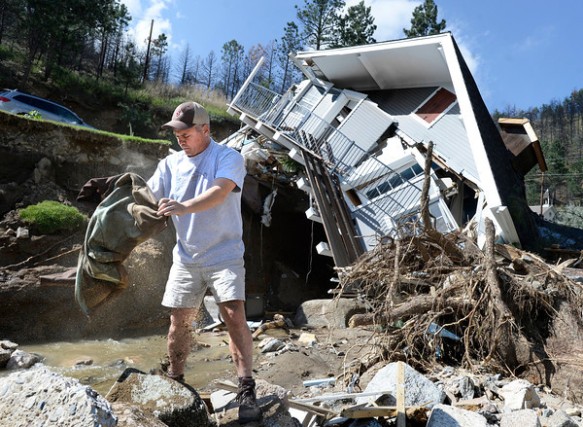
Amplifying the effect of these natural disasters is the fact that many American cities and rural towns have grotesquely under-invested in infrastructure and have a backlog of overdue maintenance orders to repair and replace structurally deficient roads, bridges, dams and levees, as well as transmission lines, transportation hubs, rail roads, drinking water systems, along with solid and hazardous waste management facilities. According to a recent American Society of Civil Engineers (ASCE) report, the U.S. received a near failing grade of a D+ on its 2013 annual infrastructure report card.
2013 REPORT CARD FOR AMERICA’S INFRASTRUCTURE
These infrastructure vulnerabilities, combined with major weather-related natural disasters are a malignancy metastasizing into cataclysmic disruptions in communication, transportation, human welfare, and the tragic loss of housing, food, water and energy supplies, and, to a greater extent, cause lasting damage to our national economy.
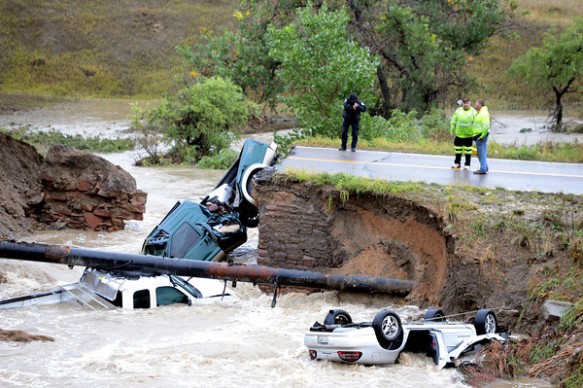
What were once considered issues for a distant future, climate change, urban sprawl, and a deteriorating national infrastructure have moved swiftly, front and center into the present, and Americans are finally beginning to wake up to the changes all around them.
A TRIFECTA OF WEATHER-RELATED TRAGEDIES
In June, President Obama told an audience at Georgetown University, “Droughts and fires and floods, they go back to ancient times. But we also know that in a world that’s warmer than it used to be, all weather events are affected by a warming planet.”
Between the wildfires last year and this year, the unprecedented and continuing drought, and the recent rain storms that dumped a year’s worth of rainfall in less than 24-hours, the state of Colorado now sits at the epicenter of a perfect storm of tragic climate events.
But considering the 1,000-year rain and 100-year flood event occurred in the backyard of some of the world’s top weather and climate research institutions, we can be confident the event will be thoroughly researched, as both the National Center for Atmospheric Research and the Earth System Research Laboratory are headquartered in Boulder. Ironically, each office was forced to close during to flooding.
FLOOD IMPACTS
According the the Colorado Office of Emergency Management, at least eight deaths have been confirmed, with two more missing and presumed dead while dozens remain unaccounted for. Over 11,000 people had be evacuated from their homes, with 700 being rescued by Black Hawk helicopters in what Lt. Col. Mitch Utterback of the Colorado National Guard described as the largest aerial rescue campaign since Hurricane Katrina in 2005.
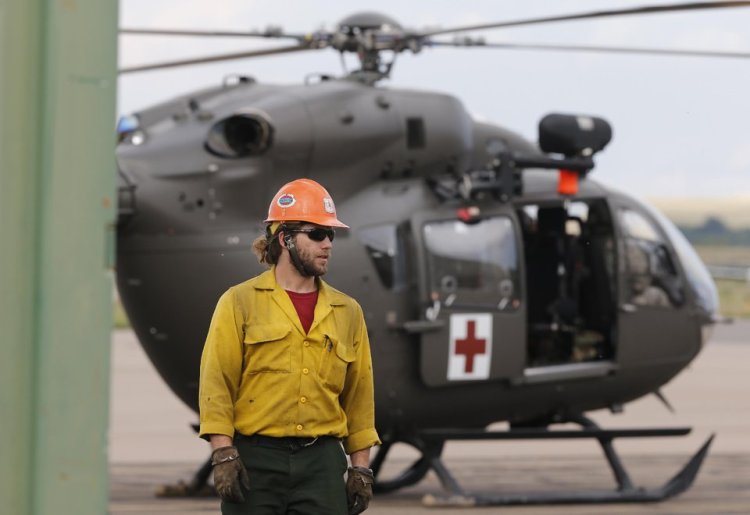
Nearly 19,000 homes have been damaged, and over 1,500 have been destroyed. The Colorado Department of Transportation estimates that at least 30 state highway bridges have been destroyed and an additional 20 are seriously damaged, with repairs for damaged bridges and roads expected to cost many millions of dollars. Miles of freight and passenger rail lines were washed out or submerged, including a section servicing Amtrak‘s iconic California Zephyr.
DROUGHT IMPACTS
According to the National Climactic Data Center, the globally-averaged temperature for August 2013 tied with 2005 as the fourth warmest August since record keeping began in 1880. August 2013 also marked the 35th consecutive August and 342nd consecutive month with a global temperature above the 20th century average.

Until the biblical floods barreled through Colorado, 90-percent of the state was in various states of drought; in some instances dating back to a decade or more. National Geographic’s Sandra Postel, believes “the long-term drought that has parched the area and gripped much of the Colorado River Basin over the past 14 years may be partly to blame for the severity of the floods. Drought tends to harden the soil. When rains do come, less of the water can absorb into the ground, so it quickly runs off the land.”
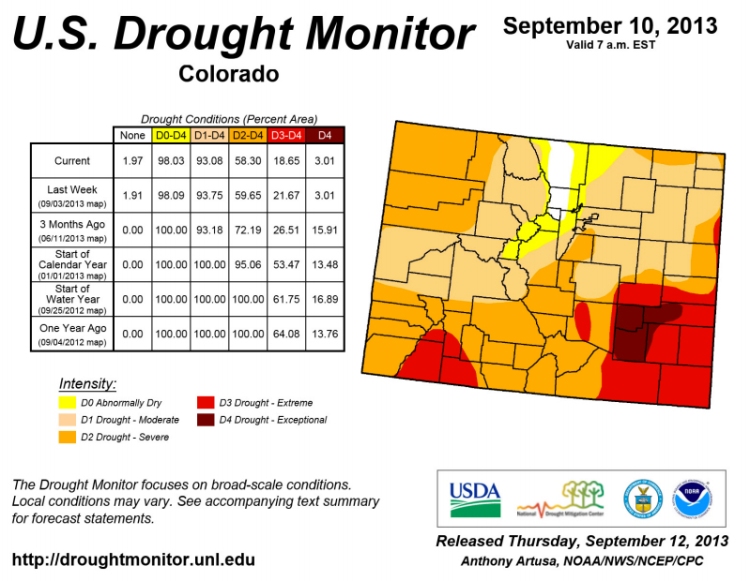
WILDFIRE IMPACTS
And if the floods and drought weren’t enough, the 2013 wildfire season was the most destructive in Colorado’s history. Over a dozen fires charred more than 150,000 acres, or approximately 234 square miles. “Fires can lead to worse flooding, because they remove vegetation that can slow down and trap rainfall,” said Postel. (See “Fire and Rain: The One-Two Punch of Flooding After Blazes.”)
Kevin Hyde, a post-doc studying post-fire erosion at the University of Wyoming, says “the compounded damages from the cycle of wildfire and flooding could very well be amplified on the Front Range in coming years. Climate models foretell larger regional storms, and scientists have also predicted bigger, more intense wildfires in Colorado’s future.” What is that going to mean for the people living in the mouth of these areas?” wonders Hyde.
If the historic droughts, record-breaking wildfires, and the 100-year flood that besieged Colorado this summer, along with the personal tragedies of lives lost and dislocated, hundreds of millions of dollars in infrastructure repair costs, crops lost, communities isolated, water quality problems, and lost revenues to businesses, are any indication of the future living in the Rocky Mountain State — with all its majesty and splendor — people better get ready for the new normal.
To support the ongoing Colorado relief and recovery efforts, donations can be made to:

Hurricane Katrina was a natural disaster that some have described as biblical in scale and unprecedented as a human tragedy.
“The Storm,” as the locals call it, was the most destructive natural disaster in American history, laying waste to 90,000 square miles of land, an area the size of the United Kingdom.
Before The Storm
As the sheer size of Hurricane Katrina became clear, the National Weather Service’s New Orleans/Baton Rouge office issued an ominously worded emergency alert predicting that many areas throughout the Gulf Coast would be “uninhabitable for weeks” after “devastating damage” caused by Katrina.
Contraflow lane reversal, voluntary, and mandatory evacuations were issued for coastal Louisiana, Mississippi, and Alabama. Approximately 1.2 million residents of the Gulf Coast heeded the evacuation orders, after hearing the following cryptic message, and fled their homes.
During The Storm
After making a brief initial landfall over Southeastern Louisiana, Hurricane Katrina made its final landfall near Louisiana/Mississippi state line, passing over the cities of Bay St. Louis and Waveland, Mississippi.
The Storm featured winds in excess of 120 mph and churned up a powerful 27-foot storm surge, which penetrated 6 miles inland, and in some areas up to 12 miles, along bays and rivers; killing close to 300 people and causing billions of dollars in damage to bridges, barges, boats, piers, houses and cars. Thousands were left homeless, destitute, and entombed in mud.
Extreme weather photographers Mike Tice and Jim Reed captured harrowing video footage as the storm surge slammed in Gulfport, Mississippi and ripped through their hotel.
After The Storm
While the coastal Mississippi communities of Bay St. Louis, Biloxi, D’Iberville, Gulfport, Pass Christian, and Waveland Mississippi where completely washed off the map because of the massive storm surge, New Orleans was overwhelmed by flooding.
Homeland Security Secretary Michael Chertoff described the aftermath of Hurricane Katrina as “probably the worst catastrophe, or set of catastrophes,” in the country’s history, referring to the hurricane itself plus the flooding of New Orleans.
Katrina’s storm surge caused 53 different levee breaches in greater New Orleans, submerging eighty percent of the city. The levee breaches and the subsequent flooding were responsible for killing over 700 people.
Survivors and evacuees reported seeing dead bodies lying in city streets and floating in flooded sections of the city well into October. The advanced state of decomposition of many corpses hindered efforts by coroners to identify many of the dead.
In the days following Katrina, residents in New Orleans who “rode out the storm,” resorted to looting stores in search of food, water, and medical supplies. While others took advantage of the situation to loot non-essential items like televisions and tennis shoes.
All told, more than 1,833 people died. The results were tragic loss of life and human suffering on a massive scale, and an undermining of confidence in our governments’ ability to plan, prepare for, and respond to national catastrophes.
On the 50th Anniversary of the March on Washington, we’d like to honor and acknowledge Presidential Medal of Freedom Recipient, Mr. Bayard Rustin, the man behind the man, the man behind the march, and the man behind the movement.
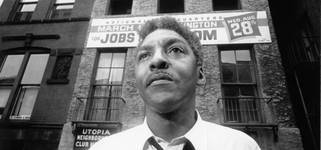
Who Is Mr. Bayard Rustin You Ask?
A master strategist and tireless activist, Bayard Rustin is best remembered as the organizer of the 1963 March on Washington, one of the largest nonviolent protests ever held in the United States. He brought Gandhi’s protest techniques to the American civil rights movement, and helped mold Martin Luther King, Jr. into an international symbol of peace and nonviolence. Despite these achievements, Rustin was silenced, threatened, arrested, beaten, imprisoned and fired from important leadership positions, largely because he was an openly gay man in a fiercely homophobic era. – Bayard Rustin Film Project
BROTHER OUTSIDER (Official Trailer)
On August, 8th 2013, President Barack Obama named Bayard Rustin a posthumous recipient of the Presidential Medal of Freedom. President Obama said, “The Presidential Medal of Freedom goes to men and women who have dedicated their own lives to enriching ours. This year’s honorees have been blessed with extraordinary talent, but what sets them apart is their gift for sharing that talent with the world. It will be my honor to present them with a token of our nation’s gratitude.”
To learn more about the life and times for Bayard Rustin, please check out the award winning feature documentary film BROTHER OUTSIDER.
How toxic is the oil dispersant Corexit when mixed with oil?
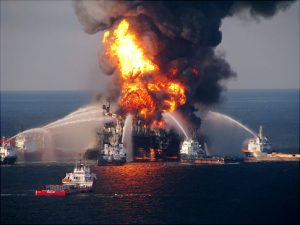
In the wake of the BP Deepwater Horizon Oil Catastrophe and the subsequent use of 2 million gallons of the oil dispersant Corexit to disperse an estimated 250-300 million gallons of oil, we find ourselves asking this question almost everyday.
Three and a half years after the largest human-caused environmental disaster in history, remediation and restoration efforts have helped to remove the most obvious signs of the disaster and returned the most affected coastal communities to near pre-spill conditions.
But Gulf Coast residents now face an even more ominous health care crisis, as untold numbers of people – cleanup workers, divers, beach comers, residents, children, etc. – have been made ill from exposure to a mix of oil, methane, Corexit, and from inhaling aerosolized oil fumes from the in-situ oil burns (oil burned in contained areas on the surface of the water).
Since 2010, the Storm Surge team has interviewed scores of people who claim to suffer from acute illnesses ranging from rashes, upper respiratory infections, severe asthma, skin infections, blisters in between their fingers and arms on their legs and their feet, and blood in their urine, to heart palpitations, kidney and liver damage, migraines, memory loss and reduced IQ, after they came into contact with oil and Corexit.
We continue to remain perplexed as to the reasons why the American mainstream media fails to cover this problem.
Last week, 60 Minutes Australia published the following two-part investigative report on the use of Corexit to disperse oil, both here in the United States and in Australia.
Crude Solution – Part 1
Crude Solution – Part 2
Meanwhile, BP is reportedly spending over $5 million a week on a nation-wide marketing, advertising, and public relations campaign to convince people across the country that the Gulf of Mexico is safe to swim in, the seafood is safe to eat, the environment is being restored to pristine order, and how great a company BP is to work for.
Traveling throughout out the Gulf Coast over the last three and a half years to record stories of unbending human resilience in the face of forces to powerful to comprehend, namely Hurricane Katrina and the BP Deepwater Horizon Oil Catastrophe, has been an amazing experience.
Music, as it relates to coping with an recovering from these disasters, is taking on a greater role in the Storm Surge narrative.
Recently, we connected with Shamarr Allen, Dee-1, Paul Sanchez, and Bennie Pete to hear them express their feelings about the Gulf oil disaster through an addictive earwig called “Sorry Aint Enough No More.” We hope you enjoy the riff.
“THINK PEOPLE!”
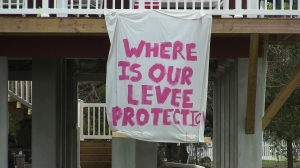
By Elizabeth Shogren of NPR – July 25, 2013
The government board charged with protecting New Orleans from flooding sued the oil and gas industry on Wednesday.
The suit would require oil, gas and pipeline companies restore damaged wetlands and pay damages for the effects of the lost wetlands on levees.
But Louisiana Gov. Bobby Jindal, who appointed the flood protection board, has a different demand. He ordered the board to drop its lawsuit and fire its lawyers.
A group of economic and polar scientists warn that the rapidly thawing Arctic and the subsequent release of methane gas into the atmosphere has the potential to trigger a catastrophic “economic timebomb” which would cost trillions of dollars and undermine the global financial system.
Meanwhile, billions of people across the planet continue to keep their heads in the sand, deny that climate change is happening, or are to apathetic to care.
The world has gone mad.
A former oil and gas executive speaks out on fracking and climate change.

Scope: Translate and transcribe approximately four (4) hours of video and audio content captured during a series of interviews with a family of Gulf Coast Vietnamese shrimp and oyster fishermen for the documentary film, Storm Surge. Their lives and livelihoods were negatively affected by the BP Deepwater Horizon Oil Catastrophe in April 2010, yet they endeavor to persevere to this day.
Schedule: 2 to 4 weeks
Compensation: Acknowledgement in the closing credits, an autographed copy of the film on DVD, and a private screening of the film once released.
About Storm Surge
Storm Surge is a production of the Moontown Foundation, an award-winning non-profit organization dedicated to creating expedition-based education and leadership development opportunities in entrepreneurship, sustainability, and social impact media for youth and young adults. Storm Surge is a multi-episode documentary film series that peers into lives of three reluctant heroes working to help their respective communities survive, rebuild, and recover in the aftermath of deadliest and most destructive disasters in American history. Storm Surge is emotional, seductively uplifting, and rejoiceful. For more information, visit www.stormsurgefilm.com.
A new study by Kerry Emanuel, a hurricane researcher at MIT, finds that tropical cyclones are likely to become both stronger and more frequent in the years to come, especially in the western North Pacific and the North Atlantic.

Emanuel’s study, published Monday in the Proceedings of the National Academy of Sciences, uses the latest generation of global climate models to power a series of high-resolution, regional simulations of tropical cyclones around the world.
On October 29th, 2012, Hurricane Sandy came ashore just northeast of Atlantic City, N.J., with a wind speed of approximately 80 mph. The storm had the worst possible trifecta of characteristics: an extremely large diameter, strong winds and high tide at landfall, which generated massive storm surge that inundated the coast from New Jersey to Connecticut.
Record surge levels were recorded in several areas of New York and New Jersey, with over 12 feet of surge in some locations. Subway tunnels flooded, airport runways flooded, power outages occurred all along the coast, natural gas lines were broken, and when it was all over, at least 650,000 homes were damaged or destroyed from the storm. On top of the estimated 72 people in the U.S. who were killed as a direct result of the storm, many more lives were lost as a result of hypothermia, house fires, vehicle accidents and other indirect causes.
This National Geographic documentary chronicles the events leading up to and immediately after Superstorm Sandy slammed into the Atlantic Seaboard.
Released in December 2012, seven years after the most expensive disaster in American history, this 95-minute documentary film gives you the round-the-clock news coverage and a comprehensive look behind the devastation caused by Hurricane Katrina, human error, false media reports, political corruption, government bureaucracy, and a substandard physical infrastructure.
Using comprehensive analysis of events, hours of government audio tapes, and personal interviews, National Geographic takes viewers into the eye of Katrina to uncover the decisions and circumstances that determined the fate of the Gulf residents.
“The truth is incontrovertible. Malice may attack it, ignorance may deride it, but in the end, there it is.” – Sir Winston Leonard Spencer Churchill
According to National Oceanic and Atmospheric Administration, 2012 was the second-most expensive year for natural disasters, claiming over 300 lives and costing more than $110 billion in damages.

Long-term, independent records from weather stations, satellites, ocean buoys, tide gauges, and many other data sources all confirm the fact that our nation, like the rest of the world, is warming, precipitation patterns are changing, sea level is rising, and some types of extreme weather events are increasing.
What’s so scary about this, it’s going to get a heck of a lot worse, before it gets better.
 On Tuesday, President Obama delivered remarks at Georgetown University, laying out his bold vision for a comprehensive plan to reduce carbon pollution, prepare our country for the impacts of climate change, and lead the international effort to address global climate change.
On Tuesday, President Obama delivered remarks at Georgetown University, laying out his bold vision for a comprehensive plan to reduce carbon pollution, prepare our country for the impacts of climate change, and lead the international effort to address global climate change.
The impacts of climate change, including severe weather, threats to public health, and our food system are affecting our economy, our communities, and our national security. In 2012, the cost of weather related disasters exceeded $110 billion in the United States, and climate change will only increase the frequency and intensity of these events.
During his historic speech, the President asked if, “we have the courage to act before it’s to late” and suggested that, “failure to do so will betray our children and future generations.”
Since 2010, my team, working under the auspice of documentary filmmakers, have witnessed many of our Nation’s disasters up close and personal. From the devastating and deadly effects of the BP oil catastrophe, to Tropical Storm Lee and Hurricane’s Isaac and Sandy, to massive tornado storms in the Great Plains, Midwest and Deep South, to wildfires in California and Colorado, and the lingering effects of blistering heat waves and drought throughout the country.
Our film, Storm Surge affirms the tragic reality that our addiction to fossil fuels and the production of CO2 are compromising everything we value as Americans — our environment, our economy and our political system — and the resulting changes in our climate will put everything we’ve accomplished as a nation into jeopardy.
Climate driven severe weather is not just a problem for the residents of the Gulf Coast, Great Plains, Midwest, or the East Coast, but for all of us.
We are doing our part to help our fellow Americans adapt to climate change, as well as build healthier, safer, and more resilient communities through the power of narrative storytelling and social impact media. We are heeding the President’s call to take action.
We hope you will join us.
Onward,
Stacy and the Team Storm Surge
You’ve heard how hurricanes, oil spills, and industrial development are affecting the Gulf of Mexico, but have you heard about the “hypoxic” or low oxygen dead zones?
The National Oceanic and Atmospheric Administration is predicting that a massive dead zone the size of New Jersey (8,561 square miles) will plague the northern Gulf of Mexico this summer, citing a combination of heavy rainfall, flooding, drought, and human activity in the Midwest as the primary culprits.
Data from the U.S. Geological Survey finds that nonpoint sources of nitrogen and phosphorus based fertilizers, animal wastes, sewage, and other nutrient-rich pollutants (i.e., lawn fertilizers) from six major tributaries along the Mississippi River watershed are flowing toward the Gulf at an alarming rate, resulting in the growth of algae blooms that deplete the waters of oxygen as they die and decompose, thereby creating a biological desert.

The USGS estimates 153,000 metric tons of nutrients flowed down the watershed to the northern Gulf of Mexico, an increase of 94,900 metric tons over last year’s 58,100 metric tons, when the region was suffering through drought. This is 16 percent above the 34 year average nutrient load.
The dead zone in the Gulf of Mexico will not only affect nationally important commercial and recreational fisheries of pogie, redfish, shrimp, crabs, oysters, and fresh water eels, but will significantly threaten the region’s economy; still reeling in the aftermath of the BP Deepwater Horizon Oil Catastrophe.

Ironically, NOAA models suggest that the size of the dead zone could be reduced by a large storm or hurricane, which would help churn up the water, thus reducing the hypoxic dead zone to roughly the size of Connecticut (5,344 square miles).
Which in and of itself is pretty big.

The US pours millions into beach relief & maintenance. But are we just putting our coastlines even more at risk? http://bit.ly/17ZzxIN
Storm Surge Film is looking for a talented Video Editor to join our team to produce a multi-episodic documentary film series and a transmedia marketing campaign on climate adaptation, disaster resiliency, and citizen action.
We are a lean, agile, and fast growing company based in Seattle, with the majority of our production work being developed in New York, New Orleans, Tuscaloosa, AL, Joplin, MS, and other locales throughout the country.
What You’ll be Working On:
You will be working with our video producers, hosts and editing team to edit and produce interesting and engaging video content. You will be a part of a production/post-production team who are talented, experienced and good at what they do. We plan on producing content at a fast pace and you will be expected to work at this pace while always keeping a focus on quality. We also expect all members of the team to contribute creatively with fresh ideas and concepts to enhance our shows or even launch new shows.
Skills/Requirements:
Responsibilities:
We are looking for video editors who love the world of documentary film production and transmedia campaign development and are looking for an editing position creating the type of content for this space.
Please don’t apply if you are a filmmaker just looking for a side job to make some extra money – these are not the type of people we want on our team. We want passionate individuals who are excited about being part of multi-year project with national ramifications.
Storm Surge Film is committed to a diverse workplace and is an enthusiastic equal opportunity employer.
Please email a cover letter, resume, and three (3) references stormsurgefilm [at]gmail [dot] com by 5:00pm, Friday, June 21, 2013. No phone calls.
Democrats from states ravaged by Superstorm Sandy ask the Obama Administration to impose tougher carbon emissions standards on power plants, suggesting the disaster makes the case for stronger actions to address climate change.
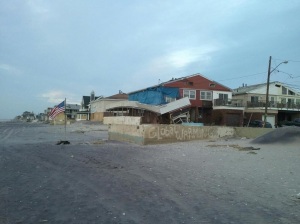
Storm Surge Films is seeking an enthusiastic individual for a documentary Research & Production Internship for the summer 2013. The internship program at Storm Surge Films is a unique opportunity for young and emerging filmmakers to learn about producing innovative documentary films alongside other passionate storytellers.
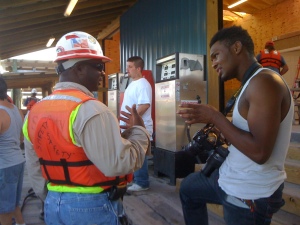
Interns will find numerous opportunities to build relationships and learn from those working in documentary, arts and non-profit communities throughout the US and beyond. Internships are ideal for candidates who bring strong individual creative sensibilities combined with an interest in participating in a highly-collaborative environment where a diversity of ideas are respected and embraced.
Self-motivated individuals with a strong entrepreneurial spirit, interested in learning about documentary films, media education and community-based outreach and engagement are encouraged to apply. S/he will work closely with the studio’s director, producer and other interns on a daily basis.
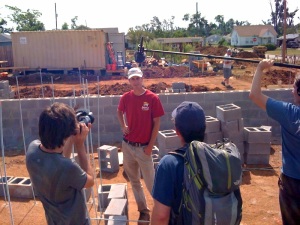
As SSF projects commonly involve the creative participation of community members typically experiencing filmmaking for the first time, it is highly desirable if candidates demonstrate an interest in education and community engagement. S/he will work closely with the studio’s director, producer and other interns on a daily basis in a highly collaborative environment where ideas are respected and embraced.
Duties may include but are certainly not limited to:
The ideal candidate should possess:
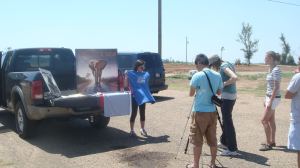
Other details:
Storm Surge Films is committed to a diverse workplace and is an enthusiastic equal opportunity employer.
Dependent upon execution and performance over a multiple month time frame, this position has the potential to become a paid part-time job.
Please email a cover letter, resume, and three (3) references stormsurgefilm [at]gmail [dot] com by 5:00pm, Friday, June 21, 2013. No phone calls.

NASA scientists report disturbing bursts of methane being emitted from the tundra as the spring thaw progressed northward over Alaska’s North Slope.
To view full report visit: http://www.nasa.gov/topics/earth/features/earth20130610.html
Just days after Superstorm Sandy slammed into the East Cost, killing 72 and causing over $50 billion in damage, the Storm Surge production team met up with members of Occupy Sandy to see firsthand how volunteers mobilized to help with the recovery and rebuilding efforts.
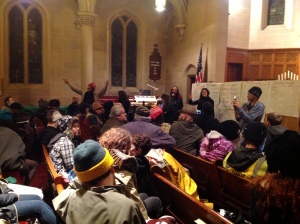
Tomorrow, June 14th, the group will host a debriefing meeting to discuss what went right, what went wrong, and identify recommendations for those who get involved in grassroots disaster relief in the future.
As a lead up to the event, Occupy Sandy released this short video to raise awareness.
If you can’t make it to NYC and want to participate remotely you can watch the livestream at http://new.livestream.com/accounts/4360121/events/2171140.
The tornado that struck El Reno Oklahoma on May 31st has now been classified as an EF-5. A DOW (Doppler On Wheels) truck recorded a wind speed of 296 MPH and the tornado was 2.6 miles wide making this the largest tornado ever recorded in modern history. The path of the tornado was 16 miles long and it was on the ground for 40 minutes. The tornado grew from 1 mile wide to 2.6 miles wide in 30 seconds.

The previous widest tornado record was the F4-rated (on the 0-5 scale) Wilber – Hallam, Nebraska twister that touched down on May 22, 2004. It had a maximum width of 2.5 miles.

The Weather Channel’s Greg Forbes provides some additional, incredible detail about the tornado’s winds on his Facebook page:
We’re quick in this country to obsessively focus on the “disaster of the moment” while forgetting about the disasters of yesterday and of yesteryear.
Last week we told you about the American Red Cross disaster preparedness app. Now, we want to hear your opinion of FEMA’s version of a disaster prep app. Their app contains disaster safety tips, interactive lists for storing your emergency kit and emergency meeting location information, and a map with open shelters and open FEMA Disaster Recovery Centers (DRCs). The app is free to download through your smartphone provider’s app store:
The FEMA App contains preparedness information for different types of disasters, an interactive checklist for emergency kits, a section to plan emergency meeting locations, information on how to stay safe and recover after a disaster, a map with FEMA Disaster Recovery Center locations (one-stop centers where disaster survivors can access key relief services) and Shelters, general ways the public can get involved before and after a disaster, and the FEMA blog.
The greatest potential for loss of life related to a hurricane is from the storm surge!
Storm surge is simply water that is pushed toward the shore by the force of the winds swirling around the storm. This advancing surge combines with the normal tides to create the hurricane storm tide, which can increase the mean water level to heights impacting roads, homes and other critical infrastructure. In addition, wind driven waves are superimposed on the storm tide. This rise in water level can cause severe flooding in coastal areas, particularly when the storm tide coincides with the normal high tides.
Hurricane Specialist, Bryan Norcoss, from the Weather Channel, explains the science behind a storm surge in the days leading up to Hurricane Isaac in August 2012.
Because much of the United States’ densely populated Atlantic and Gulf Coast coastlines lie less than 10 feet above mean sea level, the danger from storm tides is tremendous.
On May 20, 2013, a devastating EF5 tornado shredded the city of Moore, Oklahoma, killing 24 deaths and destroying an estimated $3B in property. It was the third time a tornado has stuck the city in 14 years.
In the NOVA special, Oklahoma’s Deadliest Tornadoes, we meet scientists, literally working on the front lines, in an attempt to understand when, where, how and why tornadoes form in “Tornado Alley.”
The film also asks:
On May 27, 2013, near Salinas, KS, Brandon Ivey and Sean Casey capture this amazing video from inside a massive wedge tornado.
The United States experiences more than 1,000 tornadoes a year.
While most storms are weak and occur in sparsely populated areas, recent storms have inflicted heavy casualties in more populated regions of the country. Moore, OK, Tuscaloosa, AL, and Joplin, MO are the most recent communities to suffer.
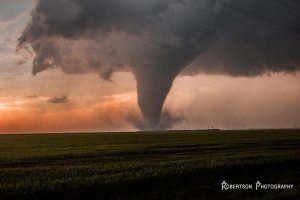
Tornadoes form when large air masses of different temperatures collide; when cold, dry air runs into warm moist air, which rises, condenses into heavy rain, and then falls in powerful downdrafts. These conditions occur most often in the Great Plains, where the high altitude jet stream from the west converges with warm, moist air moving north from the Gulf of Mexico, and warm, dry air from the southwest.
One week after a devastating tornado hit the southern Plains of Oklahoma; a similar weather pattern is being repeated.
Earlier today the NWS Storm Prediction Center issued a moderate to severe threat warning for thunderstorms, tornadoes, large hail, and damaging winds, Wednesday afternoon and evening for parts of the central and southern Plains, including parts of Nebraska, Kansas, Oklahoma and Texas.
If you live in the areas of high risk, please be alert to changing weather conditions. Look for the following danger signs:
If you see approaching storms or any of the danger signs, be prepared to TAKE SHELTER IMMEDIATELY.
FEMA’s ReadyCampaign and the Flat Stanley Project collaborate on an app to help educate school-aged children on the need to be prepared for emergencies and disasters, as well as what they can do to help their families and loved ones to build more resilient households.

By downloading the app, children and their parents can build their own FEMA Flat Stanley or Flat Stella, and then share with other children and classrooms the steps they have taken to support preparedness throughout their homes, schools and communities.
According to Flatter World, 15 percent of all schools in the U.S. use the adventures of Flat Stanley in their classroom lesson plans. And in case you did not notice, Flat Stanley’s sister, Flat Stella has joined the campaign.
When disaster strikes children often suffer the most, but if we can teach them at an early age about the risks posed by natural hazards, they will have a better chance to survive and thrive in the aftermath of a disaster.
Natural hazards, such as floods, tornadoes and hurricanes, do not need to become disasters. For example, if a hurricane churns through a location where no one lives, the hurricane is just a natural hazard, not a disaster. But if people are living in the area where the hurricane makes land fall are affected and even killed by the hurricane, in this case, the hurricane becomes a disaster.
The United Nation Office for Disaster Risk Reduction has developed a series of on-line disaster simulation games designed to teach children around the world how to protect themselves from natural hazards before they can become major disasters.
Children who play the games learn how the location and the construction materials used to build houses can make a difference when disasters strike, as well as how early warning systems, evacuation plans and education can save lives.
As the future architects, mayors, doctors, and parents of the world of tomorrow, when children know what to do to reduce the impact of disasters, they will be obliged create a safer world for the generations that come after them.
Want to give input on how to improve the national emergency management system? Join the FEMA Think Tank.
Please save the date and join Richard Serino, FEMA Deputy Administrator, for the next FEMA Think Tank conference call on May 28, 2013, from New York City.
This month’s call will be held in partnership with UNICEF and focus on the stories of disaster survivors and international emergency workers. The key objective is to encourage a more disaster survivor centric approach to emergency management at every level, and draw on experience and lessons learned to strengthen preparedness, response, and recovery efforts.
Date: Tuesday, May 28, 2013
Time: 1:00 pm to 2:30 pm Eastern
Call in Number: 1-888-740-6143
Passcode: 1202139
Captioning Link: http://fedrcc.us//Enter.aspx?EventID=2157240&CustomerID=321
Before the call, be sure to visit the online forum to share your own disaster survivor story or to submit ideas and comment on other stories or topics.
May 26 – June 1 is National Hurricane Preparedness Week
Just one week after a devastating tornado storm rips through Norman and Moore, OK, killing 24 and causing an estimated $2B in property damage, US cities now face another natural hazard, hurricanes.
June 1st is the official start of the 6-month hurricane season. For 2013, NOAA’s Atlantic Hurricane Season Outlook suggests a 70% likelihood of 13 to 20 named storms (winds of 39 mph or higher), of which 7 to 11 could become hurricanes (winds of 74 mph or higher), including 3 to 6 major hurricanes (Category 3, 4 or 5; winds of 111 mph or higher).
NOAA’s 2013 Atlantic Hurricane Season Outlook
Hurricanes can cause catastrophic damage to coastlines and several hundred miles inland. Hurricanes can produce winds exceeding 155 miles per hour as well as tornadoes and mircrobursts. Additionally, hurricanes can create storm surges along the coast and cause extensive damage from heavy rainfall. Floods and flying debris from the excessive winds are often the deadly and destructive results of these weather events.
“As we saw first-hand with Sandy, it’s important to remember that tropical storm and hurricane impacts are not limited to the coastline. Strong winds, torrential rain, flooding, and tornadoes often threaten inland areas far from where the storm first makes landfall,” said Kathryn Sullivan, Ph.D., NOAA acting administrator.
Slow moving hurricanes that churn through mountainous regions tend to produce especially heavy rain and can trigger, flash floods, landslides. or mud slides.
 Individuals who live in communities at high risk of being affected by a hurricane should consider flood insurance protection. Flood insurance is the only way to financially protect your property or business from flood damage.
Individuals who live in communities at high risk of being affected by a hurricane should consider flood insurance protection. Flood insurance is the only way to financially protect your property or business from flood damage.
To learn more about your flooding risk and how to protect yourself and your business, visit the Federal Insurance and Mitigation Administration (NFIP) Web site, www.floodsmart.gov or call 1-800-427-2419.
To learn more about how you can prepare for hurricane season, visit www.ready.gov/hurricanes.
Do you tell the death count of 24 or describe the estimated $2 billion damage to some 12,600 homes?
Do you reminisce about all the times you spent sitting in a musty cellar full of old people telling their own tornado ghost stories that frightened and intrigued you all at the same time?
Or do you admit that you intended to interview the mother of a dead boy but after watching 30 minutes of her agonizing struggle to condense 10 years of a good boy’s life into two minutes of network news, you retreated and gave both of you a break from tornado exhaustion?
Oklahoma’s Windswept Pain – by Sheila Bright
Are You Prepared to Protect Yourself, Your Family and Community from Disaster?
From extreme drought, heat waves and floods to unprecedented tornado outbreaks, hurricanes, wildfires and winter storms, millions of people throughout the US have been affected by natural disasters.
You, your family and community could be next!
Do You Know Your Risks?
Recognizing an impending hazard and knowing what to do to protect yourself and your family will help you take effective steps to prepare beforehand, respond to during, and assist in post-disaster recovery efforts.
 Some of the things you can do to prepare for the unexpected, such as assembling a supply kit and developing a family emergency plan, are the same for all types of hazards – to include natural and technological disasters, as well as terror attacks. Despite many similarities, each emergency is unique and knowing the actions to take for each threat will impact the specific decisions and preparations you make.
Some of the things you can do to prepare for the unexpected, such as assembling a supply kit and developing a family emergency plan, are the same for all types of hazards – to include natural and technological disasters, as well as terror attacks. Despite many similarities, each emergency is unique and knowing the actions to take for each threat will impact the specific decisions and preparations you make.
The American Red Cross has developed a series of mobile apps to help you get your family and home ready for a full range of disasters. These apps can help you monitor conditions in your area or throughout the disaster, and can even point you to the nearest shelter. You can also let loved ones know that you are safe even if the power is out, as well as learn what steps you should take to offer first aid to your family, friends, pets, and neighbors – all from your mobile device.
You can try these apps yourself by downloading them from the iTunes or Google Play app stores.
The National Weather Service has upgraded the tornado storm that sweep through Oklahoma on a Monday as an EF-5 on the Enhanced Fujita Scale. Initial reports suggest the tornado began 4.4 miles west of Newcastle, OK and ended 4.8 miles east of Moore, yielding an approximate tornado path length of 17 miles. The preliminary maximum damage path width is 1.3 miles.
Initial reports suggest the tornado began 4.4 miles west of Newcastle, OK and ended 4.8 miles east of Moore, yielding an approximate tornado path length of 17 miles. The preliminary maximum damage path width is 1.3 miles.
The NWS has also released the following Oklahoma Tornado Storm Recap which outlines the timeline of events.
Spawned from thunderstorms, tornadoes are one of mother nature’s most violent storms and can cause fatalities and devastate a neighborhood in a matter of seconds.
If you’re looking for ways to help residents of Oklahoma, impacted by the monstrous tornado storm on Monday, cash donations to on-the-ground relief organizations working directly with those affected is the most effective way to help.
Our friends at Do Your Part have compiled the following directory of local resources for you to consider supporting.
Please note that post disaster needs change quickly, and it is always recommend that you verify a need or service being offered in advance.
For more information, please contact Leslie Teltoe.
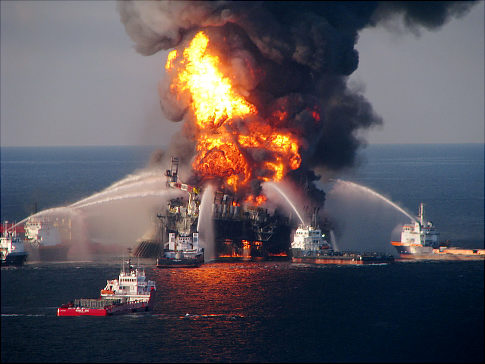
Today, the Obama Administration released the draft of its 2017-2022 plan for offshore drilling, known as the Outer Continental Shelf Oil and Gas Leasing Program. The plan proposes to prohibit drilling in the Atlantic Ocean but offers 13 new potential lease sales – 10 sales in the Gulf of Mexico, which is still healing from the disastrous BP oil spill, and three sales in the sensitive Arctic waters off the coast of Alaska.
One morning in March of last year, I set out from Gulfport, Mississippi, on a three-week mission aboard the U.S. Navy research vessel Atlantis. The 274-foot ship, painted a crisp white and blue, stood tall in the bright sunlight. On its decks were winches, cranes, seafloor-mapping sonar, a machine shop, and five laboratories. Stowed in an alcove astern was Alvin, the federal government’s only manned research submarine. “Research vessel Atlantis outbound,” A. D. Colburn, the ship’s captain, reported into the ship radio.
#POTUS announces key Executive actions to address climate change.
On Friday, President Obama plans to announce a sweeping package of commitments — over 300 in total — from companies and government agencies to increase the deployment of solar panels, and make buildings more energy efficient. The announcements will take place at a Walmart(s WMT) in Mountain View, California. While the commitments are a far cry from the kind of financing that the green stimulus provided, the announcements are the latest way for Obama to highlight his attention to environmentalism, clean energy and climate change. Earlier this week, he released the massive climate change report.
One of the more symbolic announcements will be that the White House has finally managed to install solar panels on the first family’s residence, according to reports. To note, this was a discussion started four years ago. The White House had solar panels back in the 1970’s, installed by Jimmy Carter’s administration, but…
View original post 317 more words
The African American Film Festival Releasing Movement is screening Nailah Jefferson’s critically acclaimed documentary film, Vanishing Pearls at Langston Hughes Performing Arts Center on April 28th, 2014.
The film profiles the trials and tribulations of African American fisherman working to rebuild their lives, livelihoods, and communities in the aftermath of the BP Deepwater Horizon Oil Disaster.
Please stay tuned to ticket information.
On Tuesday, March 25, 2014, we deployed to the Oso, Washington Landslide to document the disaster response and recovery life cycle from end to end. On our second day in the field, we were granted permission to venture into the 1500 foot wide primordial debris zone to witness the brave men, women, and K9 units search for victims buried under tons of mud, rocks, trees, and household materials.
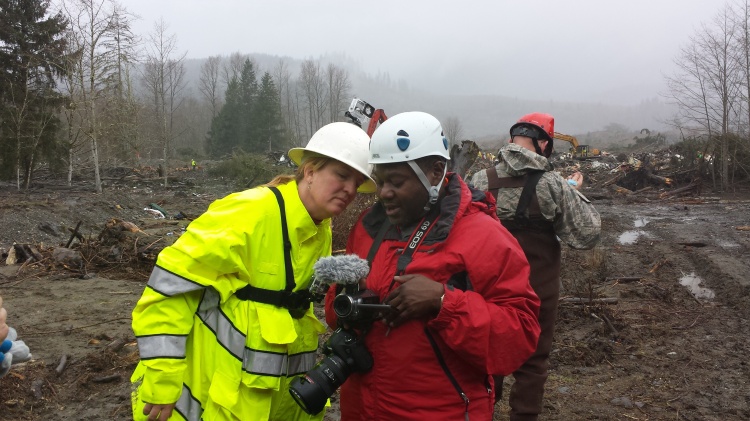
As we were making preparations to enter the slide, a women named Mary K volunteered and we accepted her offer to help take photos and shoot video inside the debris zone. Mary lost a close friend in the slide, so this was an opportunity to help honor and bring closure to her loss.
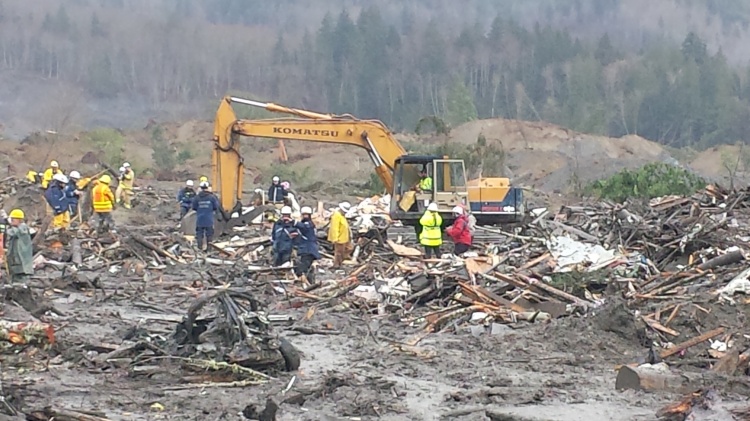
Ian MacKenzie discusses his documentary film, REACTOR, with King 5’s television news host Margret Larsen.
Friends – We will be on King5’s New Day Northwest tomorrow, Tuesday, March 11th to preview Reactor about the world post-Fukushima disaster. We’d love to have you in the audience in support of the Moontown Foundation which is sponsoring the showing of the documentary. Seats are free. Audience comes into Seattle studio about 9:30am, done by 11:30. Email for seat confirmation to newdaytickets@king5.com.